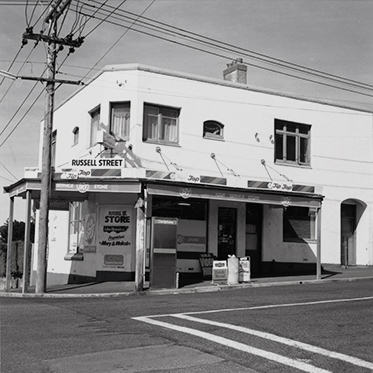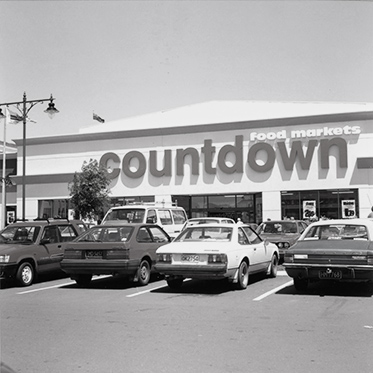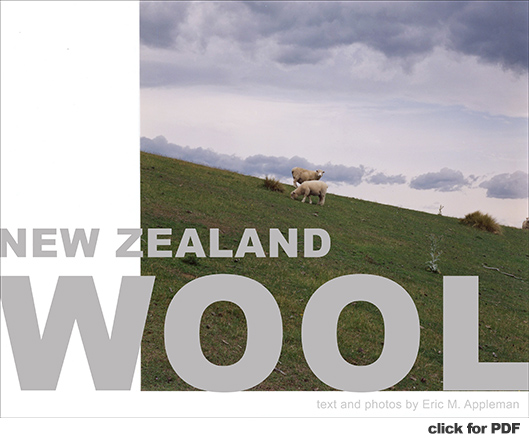New Zealand at 1993-1994
These are my observations about where New Zealand
stands today, how it arrived there and where it is
going. They are based on my visit for the 1993
election campaign and a couple of months after it. I
spent the majority of my stay in Dunedin and when
travelling I stayed at hostels and backpackers'
accomodations. Backpackers' can be found all over --
in cities and towns, on farms and in the wilderness.
Prices range from $9.90 to $20.00 per night. [Note:
all figures in this letter are in NZ$; NZ$1 =
US$.5570].
Treaty of Waitangi
It is a bit surprising to realise
that NZ is a young country by European standards.
Settlement of Otago began in the 1840s, and the
first ships for the Canterbury Settlement arrived at
Lyttelton in 1850.
In 1840, representatives of the Crown
and several hundred Maori chiefs signed the Treaty
of Waitangi, a document that set out a partnership
between Maori and Pakeha (white people) and
continues to be fundamentally important today.
However, the Maori and English versions of the
Treaty have somewhat different language. In
particular they differ over what is meant by
sovereignty which is at the core of the Treaty.
Current statistics on Maori unemployment, life
expectancy, health, single parent families...show
that the partnership was rather one-sided.
Governments have adopted various approaches to the
Maori population. For a long while there was a
Department of Maori Affairs. More recently the
government sought to direct resources to individual
iwi (tribes). The current approach is to require
that each department ensure that its programs
achieve equal outcomes for Maori and Pakeha alike;
there is also a department of Maori Development.
If the Crown failed to uphold the Treaty for much of
NZ's history, things began to change with the
establishment of the Waitangi Tribunal in
1975 and even more with the Tribunal's
reconstitution in 1985. The Tribunal now has about
400 claims before it, but relatively few
have been settled. One of the more significant
settlements, the 1992 Sealord settlement, gave the
Maori a half-interest in the commercial sea-fishing
company Sealord worth $150m. Resolving claims to
everyone's satisfaction will be difficult because
Crown land has often passed into private hands and
because it is sometimes difficult to determine who
are proper claimants. In any event, a few articles
about land claims typically appear in the newspaper
each week. For example, a front-page article in the
Press (Chch, 13 January) says that the government
intends to establish a "fiscal envelope" or overall
limit to compensation for Maori claims.
Restructuring
From the 1980s onward, NZ has undergone a
restructuring comparable to what happened in Britain
under Thatcher. Rationalization, privatization
and deregulation have been the bywords of
successive Labour and National governments as they
sought to achieve a leaner and more flexible
economy.
Examples abound. Telecom is now a private company
and is facing competition. In July, the government
sold New Zealand Rail for $328m. The government
wants to sell the power transmission company, but it
denies plans to sell the electricity wholesaler ECNZ
(also known as Electricorp). Local electricity
retailers are undergoing all sorts of combinations
and consolidations in the wake of deregulation. The
retail milk price was deregulated effective April 1.
A proposal to open coastal shipping to foreign
vessels was put forth by the previous government but
now is on hold.
Of course many state-owned enterprises (SOEs) still
exist. In addition to ECNZ, NZ Post, TVNZ (including
Television One and Channel 2) and Landcorp, a
property and farming entity, come to mind.
Another significant change was the introduction of a
goods and services tax (GST) in 1986. It now stands
at 12.5%.
1993 Election: Hold on!
The 1993 election produced a minor check to the
drive to rationalize. The National (conservative)
government went into the election with a huge
majority and emerged with a thin margin. Indeed for
ten days, until the counting of special votes, it
looked as if there would be a hung Parliament.
The message of this election was that the "decent
society" should not be entirely abandoned. People
felt that the National government should not be
allowed to have free rein in Parliament and that
there was a need for more consensus. However the
opposition Labour party did not gain as a result.
Instead two new parties, the Alliance and New
Zealand First obtained 20% of the vote and four
seats in the 99-seat Parliament; National has 50
seats and Labour 45.
In a more significant show of dissatisfaction, NZers
voted to change their electoral system from
first-past-the-post (FPP) to mixed
member-proportional (MMP). In addition, the
size of Parliament will increase to 120 members. It
is interesting to note that the majority on the
South Island voted against MMP because it will
reduce the South Island's relative strength in
Parliament.
Despite the dissatisfaction indicated by the
election results, a recent Gallup poll conducted in
about 50 countries found NZers expressing more
optimism about the future than people in most of the
countries surveyed.
Local Government
Local government was reorganized in 1989. Twelve
regional councils and four unitary authorities
exercise resource management functions similar to
counties in the U.S., focusing on such areas as
transportation, water, pest management and flood
control. At present the regional councils are all
working on policy statements -- large documents
which outline their plans for the next ten years and
make interesting reading, at least in parts. The
policy statements I have seen include significant
sections on the Maori perspective. Territorial
authorities form the second level of local
government. There are somewhere under a hundred city
and district councils.
The Economy
In 1993, NZ's economy grew at a rate exceeding all
OECD countries except Turkey which uses a different
method for calculating growth. Inflation is low, and
the NZ dollar is strong. However unemployment, at
9.1% , remains a sticky issue.
As in America, small- and medium-sized businesses
are what makes NZ run. These range from the comer
dairy, which, although in decline, is still quite
evident, to the jersey factory with 150 workers
which supplies outlets around NZ and in Australia.
NZ is a trading nation, and about 40% of its exports
of its are "agriculture and horticulture-based." The
leading exports are meat, dairy, wood and pulp,
vegetables and fruit, wool and fish and other sea
critters. One need not look far to find
export-related activity whether it be sheep in the
field, bales of wool passing by on a truck, a pine
plantation or logs piled up at a port.
For many commodities, marketing boards promote
exports. Some of these boards exercise a monopoly
and all exports must pass through them (the
single-desk system). Such is the case with the NZ
Apple & Pear Marketing Board (ENZA) whose logo
is probably familiar to you from apple boxes. ENZA
recently stifled an effort by the Apple Fields
company to export apples, but this seems unlikely to
stand for many more years. The Kiwifruit board also
exercises an export monopoly, and the Dairy Board
controls exports of cheese. The Wool Board is
probably more representative of how these boards
will function in future. Its mandate is to maximize
returns to growers and much of its budget is devoted
to promotion.
Foreign ownership cuts across the economy. Although
I'm not sure about the extent of foreign control,
there are numerous examples. American businesses
have significant interests in Telecom and NZ Rail.
In 1992 Heinz purchased the big food processing and
tomato sauce concern Watties for $567m. On a smaller
scale, Greggs, the food processing company in
Dunedin and Auckland is now part of Cerebos Greggs
which in tum is owned by Suntory. Feltex, NZ's
biggest carpet manufacturer has a British owner; the
Summit carpet yarn mill in Oamaru is owned by
Sumitomo. The house I was living in in Dunedin is
owned by someone from Hong Kong.
Media
New Zealand's biggest newspaper, the New Zealand
Herald, has a circulation of around 250,000. Other
major papers are the Press (Chch, circ. 102,000),
the Dominion and the Evening Post (Wellington) and
the Otago Daily Times (Dunedin). In televisionland,
in addition to the state-owned Television One and
Channel 2, the privately-owned TV3 now seems
well-established after rocky beginnings. Programming
includes. significant amounts of American junk such
as Donahue, Oprah, Remington Steele and Santa
Barbara; sport is popular. New Zealanders who own
television sets pay an annual fee of $110 which goes
to develop NZ programming. There is some talk about
selling Channel 2, but concerns about foreign
ownership and greater incursion of foreign
programming will likely keep this on the slow track
for some time.
Culture
Statues of her most gracious majesty Queen Victoria,
cricket and the customs of government remind one of
NZ's British heritage, NZ still has honesty boxes
for the sale of newspapers and home delivery of
milk. However, from fast food restaurants (a
McDonald's opened in Dunedin five years ago) to
second-rate American movies, to a significant
proportion of television programming, it is American
culture that is seeping in.
NZers enjoy their position of being "down under"
away from it all. Tourism is growing rapidly,
bolstered by NZ's clean, green image. Activities
such as kayaking, bungy-jumping and tramping are
abundant. NZ is now the preferred overseas
destination of Germans; I certainly met a lot of
people from Germany. From one million visitors in
1991, the tourist influx is expected to increase to
between two and three million by 2000.
The Heart of New Zealand
At the heart of any country are its natural
resources. Ship Cove in Queen Charlotte Sound at the
top· of the South Island is a good place to begin.
Captain Cook stopped here five times in his travels.
A walk on the Queen Charlotte track takes one
through native forest with towering tree ferns and
giant singing trees. On many lower slopes the forest
was burned in the last century in a futile effort to
establish sheep farms and is now slowly
regenerating.
Another good place to find New Zealand is at Lake
Taupo, the big lake in the center of the North
Island. Volcanic country is visible to the south,
and there is much geothermal activity in the area.
The Waikato River flows north from the lake and
supplies about half of the North Island's power. (NZ
households and businesses pay among the lowest
electricity prices in the world because of
hydroelectricity).
Finally, there are the beaches, many of which are at
the ends of unsealed roads, and still relatively
unvisited.
Because NZ is a small country, the outdoors seem
much more accessible than in the States. There are
concerns over exposure to the sun, "changing
weather" and even giardia, but it seems like a
greater proportion of the population finds time to
engage in outdoor pursuits like sailing, boating and
golf than in the U.S..
Of course most people live in the city, working in
offices and retail outlets. There is also a strong
rural sector based around sheep farms in South
Island, cattle in the North Island, and other
agricultural pursuits. I visited a farm near
Ranfurly (population less than 1000) located in
central Otago to get a taste of this lifestyle. If
one is running a farm it keeps one busy; otherwise
it might get a little slow at times.
Future Directions
Within three years, New Zealand will hold elections
under the MMP system. Whether this will lead to the
chaos predicted by MMP opponents remains to be seen,
but predictions are that new parties will emerge
leading to coalition governments.
New Zealand has not cut its ties to the monarchy,
but this may happen in the next decade. An editorial
in the Press (Chch, 14 January) says that "... a New
Zealand slide to republichood appears irresistible."
The editorial forsees a constitutional connection
between Australia and New Zealand, and states, "[I]t
is bound to be intimate, perhaps amounting to a
union of sorts, and will probably come about quite
rapidly."
Settlement of Maori claims, if mishandled, could
lead to friction. The bulk of claims have yet to be
resolved, and this will clearly be a major story in
the coming years.
If tourism increases as predicted, it may bring
problems in addition to foreign exchange. Already
some accomodation shortfalls are seen.
New Zealand will continue to be a trading nation.
The recently-concluded GATT negotiations should make
room for more NZ exports in the next five to ten
years.
ema 24 January 1994
 
A corner store and a
supermarket in Dunedin.
|



